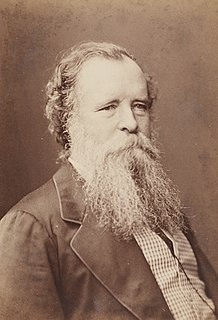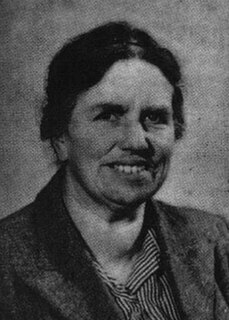
Sir Joseph Banks, 1st Baronet, was an English naturalist, botanist, and patron of the natural sciences.

Lincolnshire is a county in the East Midlands of England, with a long coastline on the North Sea to the east. It borders Norfolk to the south-east, Cambridgeshire to the south, Rutland to the south-west, Leicestershire and Nottinghamshire to the west, South Yorkshire to the north-west, and the East Riding of Yorkshire to the north. It also borders Northamptonshire in the south for just 20 yards (19 m), England's shortest county boundary. The county town is the city of Lincoln, where the county council is based.
The Linnean Society of London is a learned society dedicated to the study and dissemination of information concerning natural history, evolution, and taxonomy. It possesses several important biological specimen, manuscript and literature collections, and publishes academic journals and books on plant and animal biology. The society also awards a number of prestigious medals and prizes.

Mablethorpe is a seaside town in the East Lindsey district of Lincolnshire, England, part of the civil parish of Mablethorpe and Sutton. The population including nearby Sutton-on-Sea was 12,531 at the 2011 census and estimated at 12,633 in 2019. The town was visited regularly by Alfred, Lord Tennyson, a 19th-century Poet Laureate of the United Kingdom. Some town features have been named after him, such as Tennyson Road and the now closed Tennyson High School.

Ralph Tate was a British-born botanist and geologist, who was later active in Australia.

The Collection is the county museum and gallery for Lincolnshire in England. It is an amalgamation of the Usher Gallery and the City and County Museum. The museum part of the enterprise is housed in a new, purpose-built building close by the Usher Gallery in the city of Lincoln.

Sir William John Macleay was a Scottish-Australian politician, naturalist, zoologist, and herpetologist.

George Edward Lodge FZS, was a British illustrator of birds and an authority on falconry.
Lieutenant Colonel Edward Frederick Kelaart was a Ceylonese-born physician and naturalist. He made some of the first systematic studies from the region and described many plants and animals from Sri Lanka.
Henry Hurd Swinnerton (1875–1966) was a British geologist. He was professor of geology at University College Nottingham from 1910 to 1946.

James Eustace Bagnall ALS was an English naturalist with a particular interest in botany, especially bryology. He was the author of the first Flora of Warwickshire (VC38) in 1891. A noted bryologist, he wrote the Handbook of Mosses in the Young Collector Series, various editions of which were published between 1886 and 1910.
The Society for the History of Natural History (SHNH) is an international society for everyone who is interested in natural history in the broadest sense. This includes botany, zoology and geology as well as natural history collections, exploration, art and bibliography. Everyone with an interest in these subjects – professional or amateur – is welcome to join. The Society's Patron is Sir David Attenborough OM CH FRS.

John Cordeaux, MBOU was one of the foremost English amateur naturalist and ornithologist of his day, known for his work with the British Association on bird migration.
Frederick "Fred" Baker was an American physician and civic activist in San Diego, California. He was the prime mover in founding the Marine Biological Institution, which became the Scripps Institution of Oceanography. He was also a co-founder of the Zoological Society of San Diego and thus of the San Diego Zoo. He was a naturalist and an amateur malacologist.
Born Eleanor Fisher, the first of Ernest and Janet Fisher's two daughters, in Belfast on 16 March 1908, but known even then as "Nora", Nora Fisher McMillan, as she became, was a larger-than-life self-taught expert in natural history, especially conchology, specialising in post-glacial fresh-water Mollusca, but with broad academic interests in the history of natural history, geology and other areas, as well as being a keen amateur botanist, naturalist and local historian. She wrote prolifically, with over 400 publications to her name.
Richard Brinsley Hinds FRCS was a British naval surgeon, botanist and malacologist. He sailed on the 1835–42 voyage by HMS Sulphur to explore the Pacific Ocean, and edited the natural history reports of that expedition.

William Denison Roebuck, was an English Naturalist, collector and writer, specialising in Malacology, Conchology and Limacology. He was one of the founding members and secretary of the Yorkshire Union of Naturalists, and the editor of its journal The Naturalist.

Elizabeth Joan Gibbons was a British botanist.











